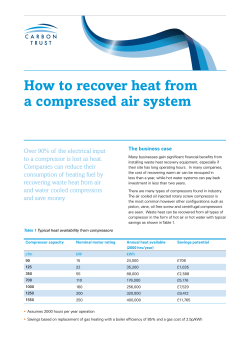
How to Measure Active Compression?
How to Measure Active Compression? • No clear consensus has been reached regarding how best to specify and document the performance of active compression units; • Of course, software-based compression might be thought to be completely specified via the underlying code. • Nonetheless, what measurements are needed will depend on the application, and the means for characterizing performance is still under investigation… Measurement of Compression Units FOCUSRITE RED 3 • Let’s look at the typical responses of three of the compressor units popular in studio use: • FOCUSRITE RED 3 • GML 8900 • DRAWMER 1960 • Response to a gated test signal were recorded for each with: – Fast Attack and Slow Release – Slow Attack and Fast Release The Red 3 is a Class A VCA-based dual mono/stereo compressor/limiter. The compressor/limiter features a single Class A VCA to achieve truly high class compression and limiting free of the usual compromises. GML 8900 Dynamic Range Controller developed to react to loudness (rather than volts) like our ears do. The 8900 uses multiple true-RMS detectors, remarkably accurate log converters, and fast peak detectors to respond intelligently to real signal energy, not just level. This unusual design employs unique controls, like Crest Factor and Release Hysteresis. DRAWMER 1960 The 1960 is a hybrid vacuum tube/semi-conductor, dual-channel compressor On Peak-Detecting and RMS Feedback and Feedforward Compressors Abel, J. S. and Berners, D. P. (Preprint 5914; Convention 115; October 2003) First: What’s the difference between feedback and feedforward compressors? Feedback and Feedforward Compressors? Feedback and Feedforward Compressors? B B B B On Peak-Detecting and RMS Feedback and Feedforward Compressors (Abel & Berners, 2003) Feedback and feedforward gain reduction trajectories were shown to be equivalent by transforming the feedback gain reduction into a feedforward gain reduction having a level-dependent time constant. This time constant has the effect of slowing down the transition into and out of compression, and accounts for much of the difference in compression character between the two architectures. On Peak-Detecting and RMS Feedback and Feedforward Compressors (Abel & Berners, 2003) This paper presents differential equations governing the behavior of first-order peak-detecting and RMS feedback and feedforward analog compressors. Based on these equations, the relationship between feedback and feedforward compressor behavior is explored, and simple, accurate digital emulations are provided.
© Copyright 2025





















